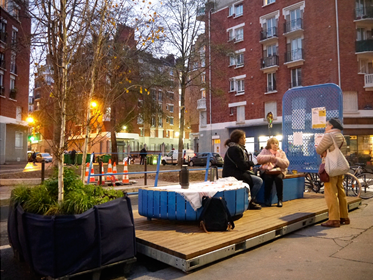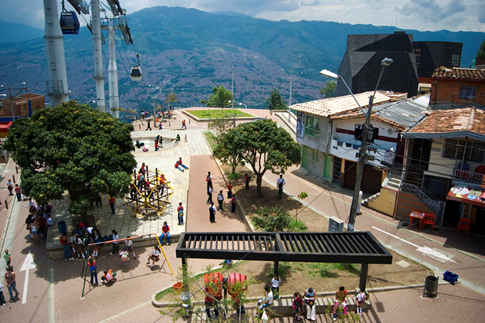[Technical Cooperation Buenos Aires] Webinar on the sharing of experience of tactical urban planning in Paris and on integration projects of vulnerable neighborhoods in Medellin
CODATU signed in April 2021 a 3-year technical cooperation agreement with the French Development Agency (AFD) and the Government of the City of Buenos Aires to support the Argentine capital in its urban planning and sustainable mobility projects.
Within the City of Buenos Aires, three entities benefit from the technical cooperation program: the Secretariat of Transport and Public Works (SECTOP), the Ministry of Public Spaces and Urban Hygiene (MEPeHU) and the City Housing Institute (IVC).
The initiatives supported are part of the response to the urban challenges identified in the light of the COVID-19 pandemic. The pandemic has had a lasting impact on the relationship between public space and the daily mobility of the inhabitants of Buenos Aires, particularly in the most vulnerable neighborhoods. The technical cooperation supports projects to improve public spaces, develop active modes of transport and improve accessibility in the city’s vulnerable neighborhoods, through the exchange of best practices and the financing of studies.
The first few months of cooperation have enabled the three entities of the City of Buenos Aires to establish a common work dynamic and to define the scope of the projects. In particular, teams decided to focus on three neighborhoods that are representative of the city’s urban and mobility issues, namely Flores, Nueva Pompeya and Villa Lugano.
Then, the first event was organized on Tuesday, July 27, 2021 in a virtual way due to the health context. This took the form of a webinar in which two international experts shared their experiences in tactical urban planning and integration of vulnerable neighborhoods with the rest of the city, followed by a virtual workshop in which the City of Buenos Aires teams worked on the selected neighborhoods.
Sharing experiences in Paris and Medellin
Stéphane Cagnot from Agence Dédale presented tactical urban planning projects implemented in Paris in 2019. Tactical urbanism is a tool for experimentation and prefiguration of permanent installations in the city aiming at implementing sustainable urban strategies. Diagnosis, citizenship participation and evaluation are key stages of the project in order to adapt it to the needs of the inhabitants and uses.
The ephemeral parklet project was presented during the webinar. It is an installation composed of a minimum of a floor and a guardrail and is located on former car parking spaces. Passers-by can stop and occupy the installation during the day. Participatory workshops were set up to orient the shape of the installation, and each parklet was associated with a thematic linked to the identity of the Paris’s district where it was to be installed (music, workplaces, reading, etc.). Five parklets were installed in total in the city and made available to residents for a few weeks.
Agence Dédale, the project’s prime contractor, then conducted an evaluation of these installations in order to learn about the feelings and experiences of users, and to make recommendations to the Paris City Council for further implementations. The experimentation was judged generally conclusive by the inhabitants who were able to appropriate these new spaces, despite some negative feedback concerning the reduction of parking spaces for cars.
The teams of the City of Buenos Aires were particularly interested in this evaluation phase which gives all its meaning to tactical urbanism interventions: it is a question of testing over a short time in order to adapt the arrangements over a longer period of time.

Francesco Orsini, Director of the Housing Department of COMFAMA (Compensation Fund of Antioquia, Colombia), presented the strategy implemented in Medellin to integrate vulnerable neighborhoods into the formal city through transportation and public space renovation projects.
The Integrated Urban Plans (PUI), carried out at the neighborhood level, were based on an initial project of passenger transport by cable (Metrocable), in order to respond to the challenge of integrating the working-class neighborhoods into the formal city of Medellin. In addition to the arrival of the cable, the PUIs included the development of green spaces (parks, squares) and the construction of public infrastructure such as libraries and soccer fields, in order to reduce the insecurity generated by the clashes between rival gangs. The PUIs also included the implementation of a housing program designed to improve the connection of housing to basic urban services and to partially reduce the situation of poor housing.
These urban projects were carried out in an integrated manner, i.e. they considered issues of transport, public space, education, health and housing. This has been crucial to the success of the strategy in Medellin, as well as the participation of the inhabitants in the decision-making process.
The City of Buenos Aires teams have identified many of the same issues that they are currently facing in vulnerable neighborhoods. Exchanges with Francesco Orsini focused on the financing tools mobilized (the PUIs were financed by the City of Medellin and with the support of international cooperation) and the consideration of gender issues (poorly taken into account in the PUIs of Medellin developed in the 2000s).

Collaborative work on the Flores, Nueva Pompeya and Villa Lugano neighborhoods in Buenos Aires
In a second phase, the City of Buenos Aires teams participated in a virtual workshop. Based on the presentations of the Paris and Medellin cases, the workshop participants carried out an analysis of the urban issues of the Flores, Nueva Pompeya and Villa Lugano neighborhoods, which constitute the territories of intervention of the technical cooperation.
Six working groups composed of representatives of the IVC, MEPeHU and SECTOP were formed. The exchanges around the cartographic supports of each district were rich and constructive. The participants familiarized themselves with these areas and identified their main characteristics (traffic axes, commercial areas, large public spaces, urban barriers and multimodal hubs), and then imagined what projects could be implemented to promote the integration of the neighborhood with the rest of the city and improve the lives of its residents.
Next steps
The discussions of the virtual workshop showed the need to carry out an in-depth territorial diagnosis of the three neighborhoods, in close coordination between the three entities of the City of Buenos Aires. This diagnosis will be organized around interviews, the compilation of reports, maps and other reference documents at the neighborhood level, and field visits in which members of the three entities will participate.
These activities will strengthen the links between the City’s teams, establish a detailed diagnosis and set the scope and objectives of the projects that will be the subject of studies financed under the technical cooperation.
